OUFTI-1 (Orbital Utility For Telecommunication Innovation)
Non-EO
Technology and Research
Launch: A launch of the OUFTI-1 CubeSat as a secondary payload on ESA's Sentinel-1B primary mission is scheduled for April 22, 2016.
Quick facts
Overview
| Mission type | Non-EO |
| Launch date | 25 Apr 2016 |
OUFTI-1 (Orbital Utility For Telecommunication Innovation)
Spacecraft Launch Mission status Experimental payloads Ground Segment References
OUFTI-1 represents the first CubeSat mission of the University of Liège, Belgium. The main objective of the project is educational. It aims at providing hands-on experience to students in the design, construction, and control of complete satellite systems that will ultimately serve as the basis for a variety of space experiments. The long-term goal is to use CubeSat missions for scientific experiments. 1) 2) 3) 4) 5) 6)
The key innovative feature of the OUFTI-1 project is to test the D-STAR (Digital Smart Technologies for Amateur Radio) system communication technique of the amateur-radio digital-communication protocol. This means, radio-communication will be used for satellite control and telemetry. The telemetry will be made available to ham-radio operators worldwide. The goal is the space qualification of this new technology so that a functional D-STAR repeater can be given to the amateur radio community. In the future, the D-STAR concept may also be used to control space experiments.
The OUFTI project was initiated in Sept. 2007 when Mr. Luc Halbach, sales manager of Spacebel, proposed to three professors of the University of Liège to test a new amateur radio digital technology in space on board of a CubeSat: the D-STAR protocol. It did not even take one month for a team of students and professors to set up around the newborn project (Ref. 14).
Background
D-STAR is an enabling communication technology, a digital voice and data protocol specification on VHF/UHF, and microwave amateur radio bands (1.2 GHz, 23 cm wavelength). D-STAR connects repeater sites over microwave and internet links to provide a wide area ham radio network. It supports Ethernet at 128 kbit/s DD (Digital Data) and DV (Digital Voice) at 4.8 kbit/s in GMSK transmission. DV uses 3600 bit/s for voice (2400 AMBE encoding, 1200 bit/s FEC) and 1.200 kbit/s for synchronization and multi-use (~ 900 bit/s is available for general use). 7) 8) 9)
The D-STAR specification defines the repeater controller/gateway communications and defines the general D-STAR network architecture.
Note: AMBE (Advanced Multi-Band Excitation) is a speech coding standard developed by Digital Voice Systems, Inc. and used in telephony systems.
• In 1999 the Japanese government funded JARL (Japanese Amateur-Radio League) to investigate new approaches to digital amateur radio technology. This extensive research involved Japanese radio manufacturers and other observers and resulted in the publication of the D-STAR protocol specification in 2001 and 2003.
• In the timeframe 2002, the Japanese company Icom Inc. provided the equipment used for development and testing of the D-STAR specification. Icom then started with the construction of the new digital technology by introducing a number of radios with D-STAR capability. D-STAR® is a registered trademark of the Icom Inc., a radio manufacturing company with HQ in Osaka, Japan.
• The D-STAR technology is in global use (the largest group of ham users is established in the USA); it is relatively affordable and is finding an increasingly large pool of ham operators with its increasing network of repeaters.
• So far (i.e., up to 2009), the D-STAR technology has only been used on the ground. It is the goal of the OUFTI-1 project to test the D-STAR technology in a satellite system. The open standard D-STAR protocol allows significant flexibility in experimentation.
However, a major problem has to be confronted: the general D-STAR radio system has no way to deal with the Doppler correction. What becomes of D-STAR in space? In fact, using D-STAR in space will have some consequences. The frequency shift due to the Doppler effect during one pass of the satellite is indeed too large for the acceptable bandwidth of the ICOM 2820 transceiver compensation capabilities of the Doppler effect. Unfortunately, this transceiver is, at the moment, the only one able to deal with D-STAR protocol available on the market.
Hence, the D-STAR Doppler effect will have to be compensated on board the OUFTI-1 spacecraft. Realizing this, there will be two system-selected doppler-compensated coverage zones: the first around ULg (University of Liège) for control and another one must be determined dynamically. Concerning the second zone, there will probably be a registration procedure on the Ulg website for the user community to reserve one pass of the satellite over a specific region (Ref. 14).
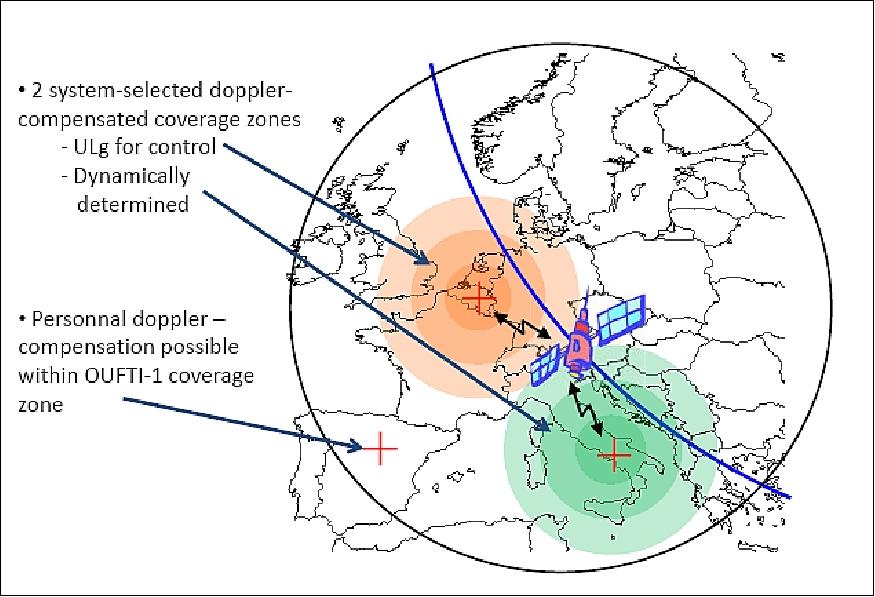
Spacecraft
The OUFTI-1 spacecraft complies to the CubeSat standard of 10 cm side length and a mass of ≤ 1 kg. The CubeSat structure is based on Pumpkin's CubeSat kit. It comprises the main structure together with the FM430 flight module (FM430 flight module with Texas Instruments single-chip 16-bit MSP430). The spacecraft configuration is achieved using CATIA software. The objective is to position the different satellite components, 5 PCBs (Printed Circuit Boards), in an optimal manner (temperature and radiations issues) and within the available volume. Constraints on the location of the center of mass specified by the CubeSat design specifications must also be fulfilled. 10) 11) 12) 13) 14) 15) 16)
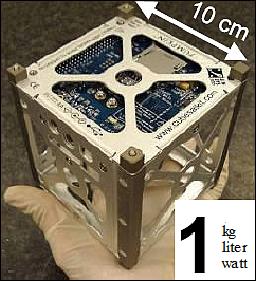
The ADCS (Attitude Determination and Control Subsystem) relies on simple passive magnetic stabilization since the D-STAR telecommunications subsystem does not require the satellite to point into a specific direction. The ADCS is of Delfi-C3 heritage. Use of permanent magnets with hysteretic materials.
The EPS (Electrical Power Subsystem) provides power using surface-mounted triple-junction GaAs solar cells (5 solar panels with 30% efficiency). The mean power available is 3.1 W. The energy is stored in Li-polymer batteries. OUFTI-1 features two PCDUs (Power Control and Distribution Units): one "classical" PCDU and an experimental PCDU developed in collaboration with Thales Alenia Space ETCA, Belgium. The regulated power bus provides power at 3.3 V, 5.0 V and 7.2 V.
The OBC subsystem controls the data flow on board the spacecraft. Its main tasks involve supervision of OUFTI-1 operation, telemetry data formatting and storage, telecommand data decoding and management. It must also provide a time reference. Pumpkin's FM430 is the prime OBC (On-Board Computer) and use of a homemade microcontroller (OBC2) for reasons of redundancy (only one is active at a time to save power). Use of FreeRTOS, open-source, lightweight, real-time OS (Operational System). 17)
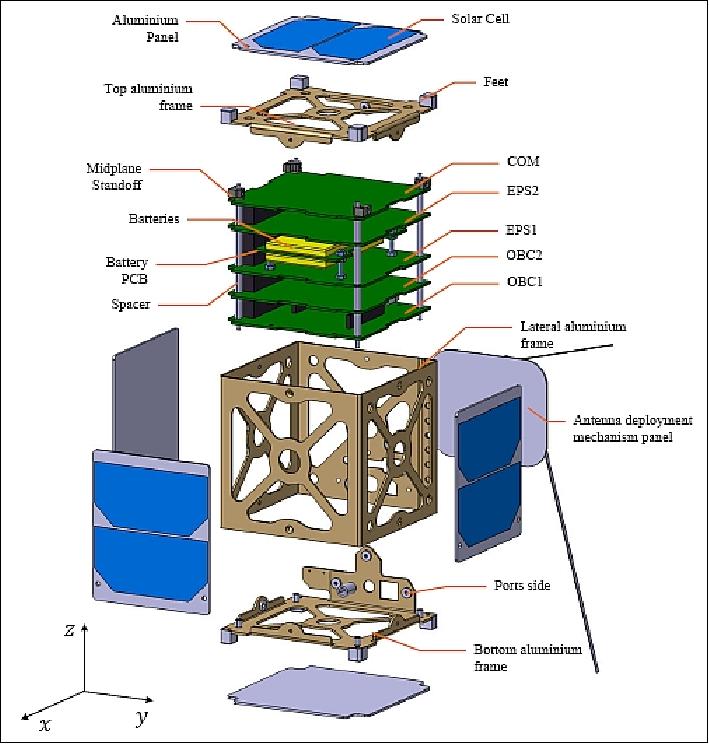
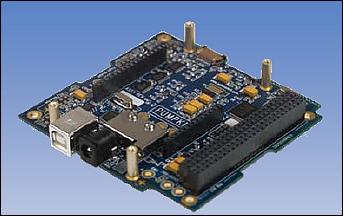
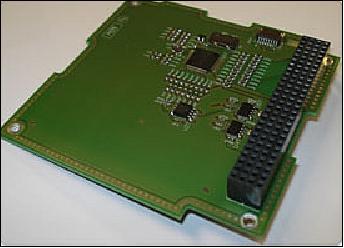
The thermal control subsystem is fully passive. Thermal control is achieved using carefully selected surface finishes and appropriate configuration.
The monopole antennas will be folded during launch and have to be deployed once in-orbit. The two antenna rods have a length of 170 mm (beacon) and 500 mm (D-STAR and AX.25). The design of the mechanical antenna release system uses a thermal knife and retention wires.
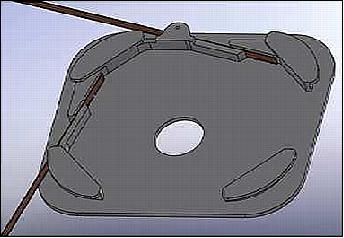
RF communications: The OUFTI-1 implementation of the subsystem relies on three channels of communication: 18)
• D-STAR: Use of VHF (145 MHz) for the uplink and UHF (435 MHz) for the downlink. Simultaneous data and voice digital transmission (data at 1.2 kbit/s, voice at 3.6 kbit/s with AMBE encoding, GMSK modulation).
• AX25: Ham radio protocol (G3RUH modem, 9.6 kbit/s, 2 FSK modulators). AX.25 is mainly used for telecommands & telemetry (CCSDS format). The AX.25 protocol has been selected for TC/TM to avoid TC/TM relying on the experimental communication payload.
• CW (Continuous Wave) beacon. The beacon is active at all times. The independent system contains some housekeeping data. In the event of a failure of main communication channels, the beacon data can be used to determine the cause of a possible malfunction.
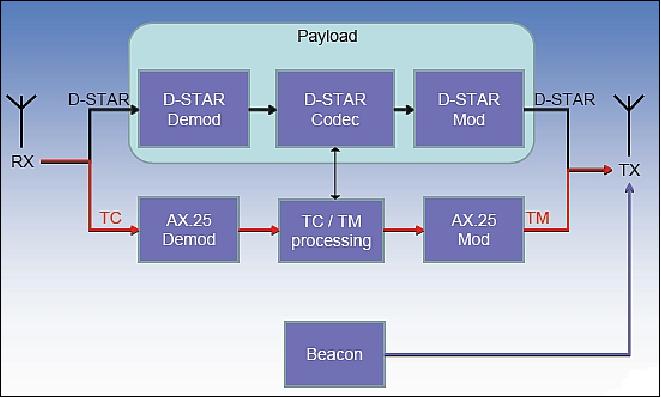
Launch
The OUFTI-1 CubeSat was launched as a secondary payload on ESA's Sentinel-1B primary mission on April 25, 2016 (21:02:13 UTC). The launcher was a Soyuz-STA/Fregat vehicle and the launch site was Kourou. 19) 20)
Note: In Oct. 2007, the OUFTI-1 project was selected as one of 9 CubeSats by ESA's Education Office for a free launch on the maiden flight of the Vega vehicle of ASI and ESA. However, in 2011 it turned out that the student-run project OUFTI-1 was not ready for a launch on Vega in January 2012 from Kourou. 21)
Orbit of Sentinel-1B: Sun-synchronous near-circular dawn-dusk orbit, altitude = 693 km, inclination = 98.18º, orbital period = 98.6 minutes, ground track repeat cycle = 12 days (175 orbits/cycle). An exact repeat cycle is needed for InSAR (Interferometric Synthetic Aperture Radar) support. LTAN (Local Time on Ascending Node) = 18:00 hours.
Secondary payloads of Sentinel-1B: 22) 23)
• MicroSCOPE, a minisatellite (303 kg) of CNES (French Space Agency) which will test the universality of free fall.
• OUFTI-1 (Orbital Utility for Telecommunication Innovation), a 1U CubeSat from the University of Liège, Belgium; the goal is to test a new communications subsystem.
• e-st@r-II (Educational SaTellite @ politecnico di toRino-II), a 1U CubeSat from the Polytechnic of Turin, Italy; the objective is to demonstrate an attitude determination system that uses measurements of the Earth's magnetic field.
• AAUSAT4, a 1U CubeSat from the University of Aalborg, Denmark; AAUSAT4 operates an AIS (Automated Identification System) receiver to identify and track the position of ships transiting away from coastal areas.
Tyvak International installed the three CubeSats in the orbital deployer. The three CubeSats are part of ESA's FYS (Fly Your Satellite) student program.
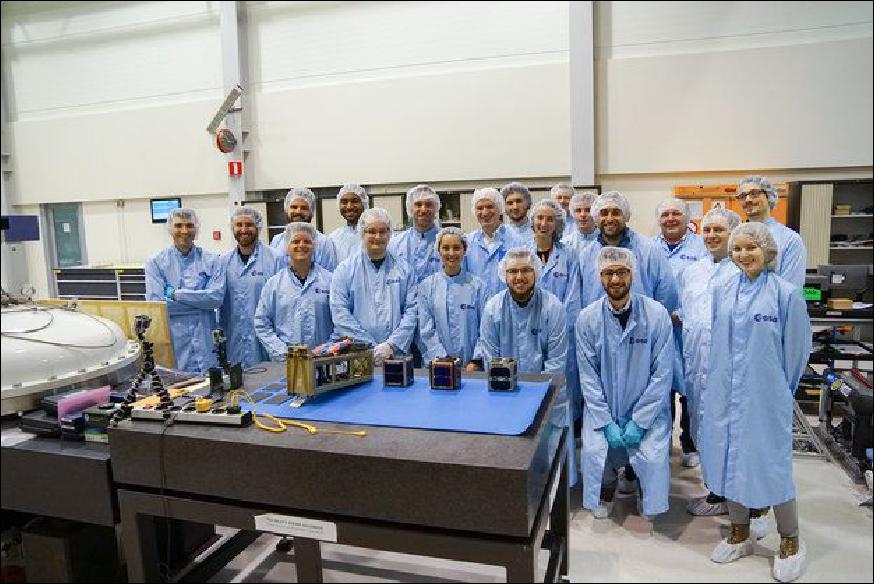
Mission Status
• March 02, 2018: Unfortunately, OUFTI-1 is no longer operational. The mission was to be operational for one year. But after 12 days of deployment, OUFTI-1 stopped transmitting and we could no longer communicate with the satellite. 24)
- The team is now working on a new satellite called OUFTI-2 which is an optimized version of OUFTI-1 with the same main payload (D-STAR) and two new secondary payloads.
- In addition to this project, the University of Liège is working on a 3U CubeSat for the observation of the Earth in the middle infrared. The objective of this payload is the measurement of hydric stress in agricultural fields in order to establish an intelligent irrigation strategy.
• April 26, 2016: All three satellites of the ESA's Education Office Fly Your Satellite! program have established their first contact with the ground. The student teams responsible for these missions have now started checking out their spacecraft and preparing to conduct the missions that the satellites were designed to perform. 25)
• April 26, 2016: Deployment sequence of the secondary payloads: 26) 27)
- The trio of "Fly Your Satellite!" student-built CubeSats were released into space at 23:50 GMT (2 hours 48 minutes after liftoff). Transmissions from the Fregat upper stage show that the door on the CubeSat deployer opened regularly, around 2 hours and 48 minutes after launch. Now the CubeSats are travelling in their final orbits, and their university teams are waiting for them to establish contact. - In the first hour of flight, the CubeSats will be working autonomously in order to stabilize their motion, perform an internal health check, and deploy their antennae. Then they will establish communication with Earth.
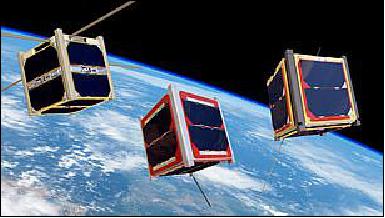
- The CubeSats were deployed into an elliptical orbit of 665 km x 453 km. From this orbit they will re-enter Earth's atmosphere in approximately 8 years, preventing they become space junk after their missions are over.
- The MicroSCOPE minisatellite of CNES was the last deployment in the launch sequence at 01:02 GMT (4 hours into the flight) on April 26.
Experimental Payloads (D-STAR, Solar cells, PCDU)
D-STAR (Digital Smart Technologies for Amateur Radio)
The OUFTI-1 mission represents the first implementation of the D-STAR communication technology on a satellite. The overall system provides a lot of new built-in features including digital communication (i.e., the quality of the data received is better than an analog signal at the same strength), simultaneous voice and data transmission, complete routing over the internet and callsign-based roaming on a worldwide basis. Therefore, the D-STAR system provides a new capability and functionality to the ham radio world and increases the efficiency of emergency communications.
The D-STAR capability of OUFTI-1 is used to provide a repeater functionality to any D-STAR equipped ham-radio operator, as long as he lies in the footprint of the satellite. User 1 may communicate via OUFTI-1 with user 2 or another ground-based repeater which also has to lie within the current footprint of the satellite.
D-STAR Connectivity
There are several possibilities for establishing a communication between two users.
1) Direct communication: The simplest one is a direct communication from one user to the other. Of course, the two users must be close enough to establish the link. Users can operate from a fixed ham-radio station, from a "mobile" station (typically in a car), or even from a "portable" station. In the OUFTI-1 context, direct communication is possible when user 1 and user 2 happen to be in the same footprint of the satellite.

2) Indirect communication: Users can communicate over longer distances, and/or overcome obstacles, by using a repeater. Of course, they must both be within radio coverage of the repeater. To increase coverage, repeaters can also be linked together to constitute a so-called "D-STAR zone". This is typically done by microwave links.
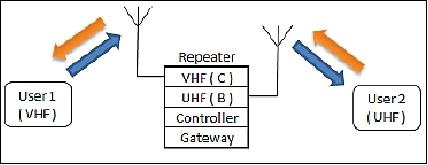
3) Indirect communication: Finally, a repeater can be connected to other repeaters (and thus to other zones when available) anywhere in the world by a gateway computer connected to the Internet. This offers global connectivity.
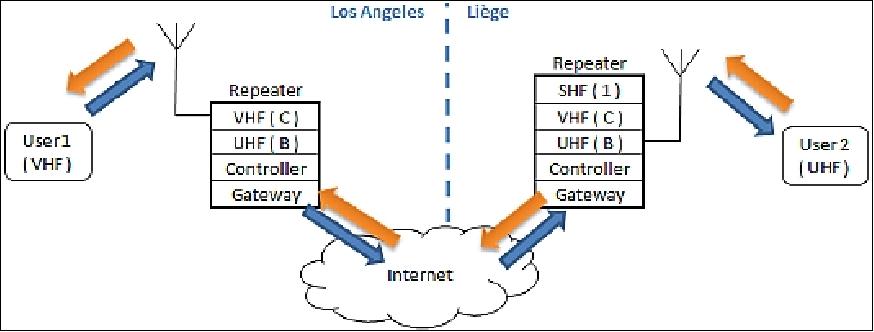
In the indirect communication cases, user 1 is "local" and connects to the repeater by radio, while user B is "distant" and communicates with the repeater either by radio or over the Internet.
In D-STAR communications, users are characterized by identities called "callsigns". The same is true for repeaters. There are typically a source user, a destination user, a source repeater, and a destination repeater. In the D-STAR terminology, the callsign of the source user (typically ourselves) is called the "MY" callsign and that of the destination user the "UR" (Your) callsign. Also in the D-STAR terminology, the source repeater is called "RPT1", and the destination repeater "RPT2".
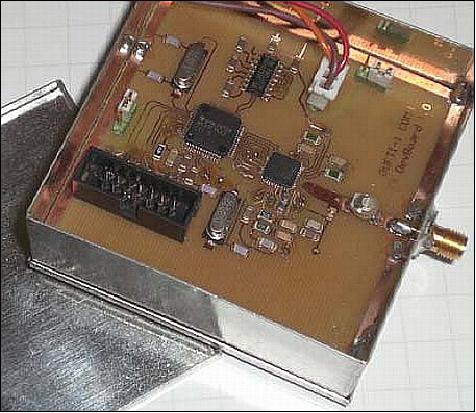
Secondary Payloads
Experimental solar cells: Azur Space Solar Power GmbH proposed to test (and space qualify) their new solar cells. These are 30% efficiency triple junction GaAs cells.
Experimental PCDU (Power Control and Distribution Unit) of Thales Alenia Space ETCA: The objective is to demonstrate its functional operation. This innovative PCDU is digitally controlled and based on a PIC microcontroller and other components such as planar transformers. When the batteries voltage is high enough (and the CubeSat functions nominally), then the digital PCDU will be switched to the 3.3 V power bus.
Ground Segment
The OUFTI-1 spacecraft can be used in two different modes. The first mode is the command-and control mode used to control the CubeSat and to downlink the telemetry to understand the operational of the spacecraft. This mode employs the AX.25 protocol. - The second mode is the D-STAR user-to-user mode in the D-STAR communication channel.
The OUFTI-1 ground system consists of the control segment and the D-STAR user segment as shown in Figure 14. The control and monitoring of the satellite is performed by the satellite operators at the University of Liège. The user segment involves the use (testing and demonstration) of the D-STAR relay service by the global amateur radio community.

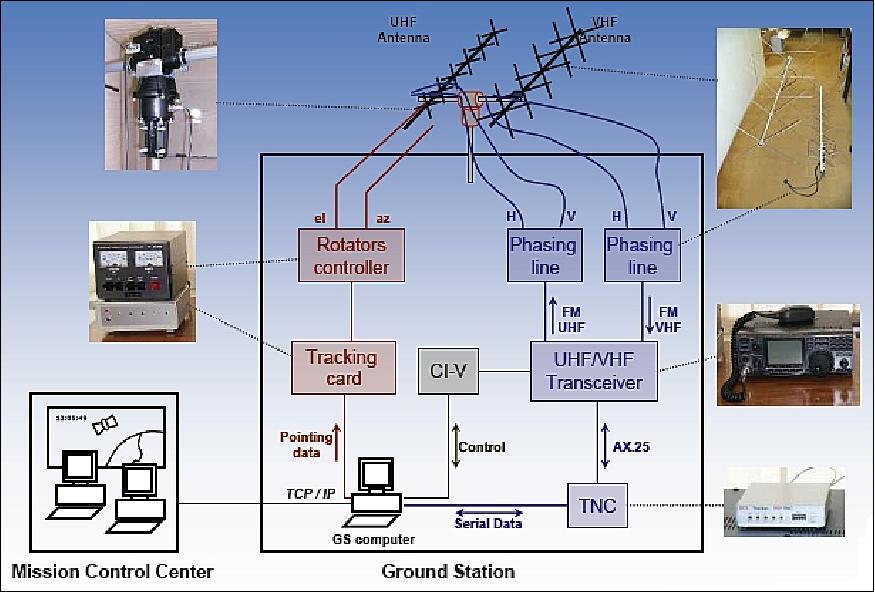
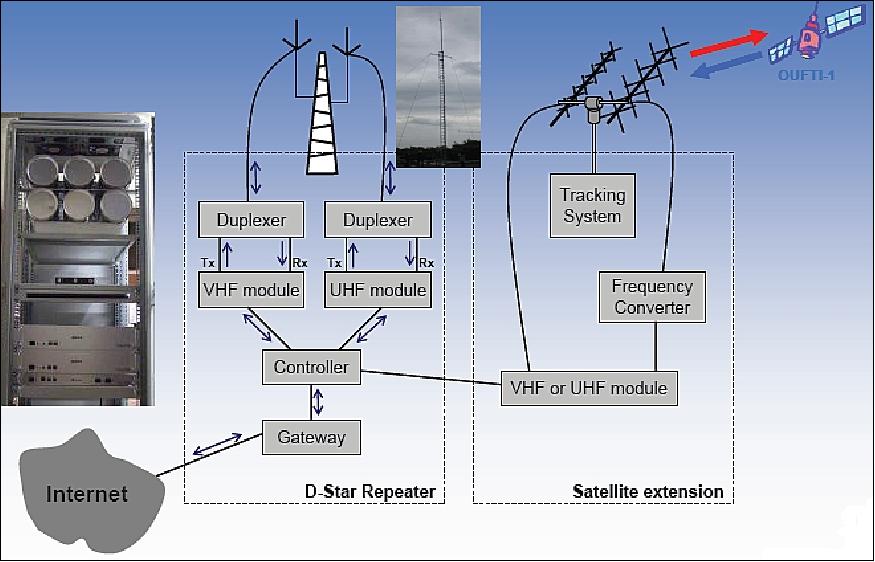
References
1) http://www.leodium.ulg.ac.be/cmsms/
2) S. Galli, J. Pisane, P. Ledent, A. Denis, J. F. Vandenrijt,P. Rochus, J. Verly, G. Kerschen, L. Halbach, "OUFTI-1 - The CubeSat developed at the University of Liège, Belgium," Proceedings of the 5th CubeSat Developers' Workshop, San Luis Obispo, CA, USA, April 9-11, 2008, URL: http://mstl.atl.calpoly.edu/~workshop/archive/2008/Spring/Day%201/1100%20-%20Denis%20-%20OuFTI-1.pdf
3) Jonathan Pisane, "Design and implementation of the terrestrial and space telecommunication elements of the student nanosatellite of the University if Liège," Masters Thesis, 2008, URL: http://www.leodium.ulg.ac.be/cmsms/uploads/07-08_Pisane.pdf
4) Amandine Denis, Jonathan Pisane, "OUFTI-1 - The educative nanosatellite of the University of Liège, Belgium," Proceedings of the 60th IAC (International Astronautical Congress), Daejeon, Korea, Oct. 12-16, 2009, IAC-09.E1.1.9
5) Amandine Denis, Jerome Wertz, Jonathan Pisane, Gaetan Kerschen, "Holding a technical review in an educational project: implementation and lessons lerned," Proceedings of the 61st IAC (International Astronautical Congress), Prague, Czech Republic, Sept. 27-Oct. 1, 2010, paper: IAC-10.E1.2.7, URL: http://www.leodium.ulg.ac.be/cmsms/uploads/IAC-10_E1_2_7.pdf
6) Amandine Denis, Jonathan Pisane, Jacques Verly, Gaetan Kerschen, "Educational assessment of four years of CubeSat activities at the University of Liège, Belgium," Proceedings of IAC 2011 (62nd International Astronautical Congress), Cape Town, South Africa, Oct. 3-7, 2011, paper: IAC-11.E1.2.8
7) Peter Loveall, "D-STAR® Uncovered," URL: http://www.aprs-is.net/downloads/DStar/DSTARUncovered.pdf
8) http://en.wikipedia.org/wiki/D-STAR
9) http://www.tapr.org/pdf/DStar_brochure.pdf
10) Renaud Henrard, Gauthier Pierlot, Damien Teny, V. Beukelaers, L. Chiarello, N. Evrard, S. Hannay, J. Hardy, L. Jacques, P. Ledent, F. Mahy, P. Thirion, J. Wertz, "OUFTI-1 - The CubeSat developed at the University of Liège, Belgium," URL: http://www.leodium.ulg.ac.be/cmsms/index.php?page=satellite
11) "OUFTI-1 - Realizations and prospects," June 18, 2009, URL: http://www.leodium.ulg.ac.be/cmsms/uploads
/2009_06_18_Realisations-prospects.pdf
12) L. Chiarello, M. Kaut, L. Rainaut, J. Wertz, "OUFTI-1 - The first nanosatellite developed at the University of Liège, Belgium," PiNa Workshop, Würzburg, Germany, Oct. 1, 2009, URL: http://www.leodium.ulg.ac.be/cmsms/uploads/2009_10_01_Wurzburg_OUFTI-1_ULG.pdf
13) Damien Teney, "Design and implementation of on-board processor and software of Student nanosatellite OUFTI-1," Master thesis, 2009, URL: http://www.leodium.ulg.ac.be/cmsms/uploads/08-09_Teney.zip
14) Lionel Jacques, "Thermal Design of the OUFTI-1 Nanosatellite," Master thesis, 2008-2009, URL: http://www.leodium.ulg.ac.be/cmsms/uploads/08-09_Jacques.pdf
15) "OUFTI-1 Status and perspectives," June 29, 2011, URL: http://www.leodium.ulg.ac.be/cmsms/uploads/2011_06_
29%20Status%20and%20perspectives.pdf
16) Sebastien De Dijcker, Nicolas Crosset, Jacques Verly, Amandine Denis, "OUFTI-1 Design of the On-Board Computer of the Belgian OUFTI-1 CubeSat," 8th Annual Developer's Workshop, April 20-22, 2011, San Luis Obispo, CA, USA, URL: http://www.leodium.ulg.ac.be/cmsms/uploads/2011_04_22_CalPoly_De_Dijcker_OUFTI-1.pdf
17) Sebastien De Dijcker, Nicolas Crosset, Jacques Verly, Amandine Denis, "OUFTI-1 : Design of the On-Board Computer of the Belgian OUFTI-1 CubeSat," 8th Annual CubeSat Developers' Workshop, CalPoly, San Luis Obispo, CA, USA, April 20-22, 2011; URL: http://www.cubesat.org/images/2011_Spring_Workshop/
fri_a11.30_dedijcker_oufti-1.pdf
18) OUFTI-1 Newsletter No 2, Jan. 20, 2010, URL: http://www.leodium.ulg.ac.be/cmsms/uploads/OUFTI-1%20Newsletter%202.pdf
19) "CubeSat launch replay," ESA, April 26, 2016, URL: http://www.esa.int/spaceinvideos/Videos/2016/0
4/CubeSat_launch_replay
20) "Belgian staudents closer to their 'ticket to orbit'," ESA October 22, 2014, URL: http://www.esa.int/Education/Belgian_students_closer_to_their_Ticket_to_Orbit!
21) Information provided by Amandine Denis of the University of Liège, Belgium.
22) "Approxching launch: student CubeSats integrated on theit orbital deployer," ESA, March 17, 2016, URL: http://www.esa.int/Education/CubeSats_-_Fly_Your_Satellite/
Approaching_launch_Student_CubeSats_integrated_in_their_orbital_deployer
23) "Launch campaign started: CubeSats arrived at Kourou Spaceport," ESA, March 31, 2016, URL: http://www.esa.int/Education/CubeSats_-_Fly_Your
_Satellite/Launch_campaign_started_CubeSats_arrived_at_Kourou_spaceport
24) Information provided by Xavier Werner of the University of Liège,Liège, Belgium.
25) "Fly your satellite! CubeSats phoned home," ESA, April 26, 2016, URL: http://www.esa.int/Education/CubeSats_-_Fly
_Your_Satellite/Fly_Your_Satellite!_CubeSats_phoned_home
26) "Student satellites fly freely on their orbit in space," ESA, April 26, 2016, URL: http://www.esa.int/Education/CubeSats_-_Fly_Your
_Satellite/Student_satellites_fly_freely_on_their_orbit_in_space
27) "Soyuz demonstrates Arianespace mission flexibility," Space Daily, April 26, 2016, URL: http://www.spacedaily.com/reports/Soyuz_demonstrates
Arianespace_mission_flexibility_999.html
The information compiled and edited in this article was provided by Herbert J. Kramer from his documentation of: "Observation of the Earth and Its Environment: Survey of Missions and Sensors" (Springer Verlag) as well as many other sources after the publication of the 4th edition in 2002. - Comments and corrections to this article are always welcome for further updates (eoportal@symbios.space).
Spacecraft Launch Mission status Experimental payloads Ground Segment References Back to top